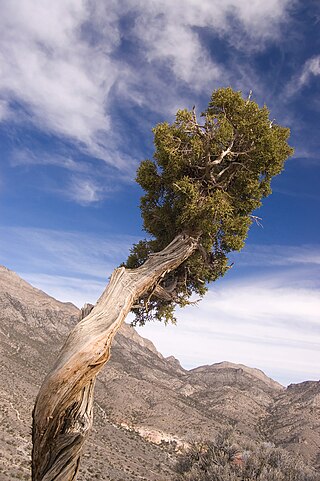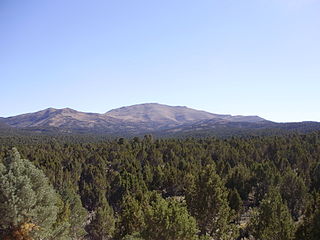
Mistletoe is the common name for obligate hemiparasitic plants in the order Santalales. They are attached to their host tree or shrub by a structure called the haustorium, through which they extract water and nutrients from the host plant.

Junipers are coniferous trees and shrubs in the genus Juniperus of the cypress family Cupressaceae. Depending on the taxonomy, between 50 and 67 species of junipers are widely distributed throughout the Northern Hemisphere, from the Arctic, south to tropical Africa, throughout parts of western, central and southern Asia, east to eastern Tibet in the Old World, and in the mountains of Central America. The highest-known juniper forest occurs at an altitude of 4,900 metres (16,100 ft) in southeastern Tibet and the northern Himalayas, creating one of the highest tree lines on earth.

Quercus petraea, commonly known as the sessile oak, Cornish oak, Irish Oak or durmast oak, is a species of oak tree native to most of Europe and into Anatolia and Iran. The sessile oak is the national tree of Ireland, and an unofficial emblem in Wales and Cornwall.

Juniperus virginiana, also known as eastern redcedar, red cedar, Virginian juniper, eastern juniper, red juniper, and other local names, is a species of juniper native to eastern North America from southeastern Canada to the Gulf of Mexico and east of the Great Plains. Further west it is replaced by the related Juniperus scopulorum and to the southwest by Juniperus ashei.

Juniperus ashei is a drought-tolerant evergreen tree, native from northeastern Mexico and the south-central United States to southern Missouri. The largest areas are in central Texas, where extensive stands occur. Ashe juniper grows up to 10 metres tall, and over time can reach 15 m (49 ft), and provides erosion control and year-round shade for wildlife and livestock.

Uvas Canyon County Park is a 1,147-acre (464 ha) natural park located in upper Uvas Canyon on the eastern side of the Santa Cruz Mountains, west of Morgan Hill, California. The park has several small waterfalls, some of which flow perennially, that feed into tributaries confluent with Uvas Creek. The park is part of the Santa Clara County Parks System, and facilitates picnics, hiking and overnight camping. It is one of the few parks in the area that allows dogs in the campgrounds.

Quercus coccifera, the kermes oak, is an oak bush in the Ilex section of the genus. It is native to the Mediterranean region and Northern African Maghreb, south to north from Morocco to France and west to east from Portugal to Cyprus and Turkey, crossing Spain, Italy, Libya, Balkans, and Greece, including Crete. The Kermes Oak was historically important as the food plant of the Kermes scale insect, from which a red dye called crimson was obtained. The etymology of the specific name coccifera is related to the production of red cochineal (crimson) dye and derived from Latin coccum which was from Greek κόκκος, the kermes insect. The Latin -fera means 'bearer'.

The woodlands of the Iberian Peninsula are distinct ecosystems on the Iberian Peninsula. Although the various regions are each characterized by distinct vegetation, the borders between these regions are not clearly defined, and there are some similarities across the peninsula.
Juniperus saltillensis is a species of conifer in the family Cupressaceae.

The Florida scrub jay is one of the species of scrub jay native to North America. It is the only species of bird endemic to the U.S. state of Florida and one of only 15 species endemic to the continental United States. Because of this, it is keenly sought by birders. It is known to have been present in Florida as a distinct species for at least 2 million years, and is possibly derived from the ancestors of Woodhouse's scrub jay.

Pinyon–juniper woodland, also spelled piñon–juniper woodland, is a vegetation type (biome) of Western United States higher elevation deserts, characterized by being an open forest dominated by low, bushy, evergreen junipers, pinyon pines, and their associates which vary from region to region. The woodland's density and crown height varies dramatically depending on the site's soil and climate, the age of the stand, and the particular species present, with mature trees ranging in height from as low as 2 meters up to 15 meters. At lower elevations, junipers often predominate and trees are spaced widely, bordering on and mingling with grassland or shrubland. As elevation increases, pinyon pines become common and trees grow closer, forming denser canopies. Historically, pinyon-juniper woodland has provided a vital source of fuel and food for peoples of the American Southwest.

Ditula angustiorana, the red-barred tortrix, is a moth of the family Tortricidae found in Africa, Asia, Europe and North Africa. Other common names are the fruit-tree tortrix and the vine tortrix. The moth was first described by Adrian Hardy Haworth in 1811.

The pinyon jay is a species of jay, and is the only member of the genus Gymnorhinus. Native to Western North America, the species ranges from central Oregon to northern Baja California, and eastward as far as western Oklahoma, though wanderers are often sighted beyond this range. It is typically found within foothills, especially where pinyon pines occur.

The Sierra del Carmen, also called the Sierra Maderas del Carmen, is a northern finger of the Sierra Madre Oriental in the state of Coahuila, Mexico. The Sierra begins at the Rio Grande at Big Bend National Park and extends southeast for about 72 kilometres (45 mi), reaching a maximum elevation of 2,720 metres (8,920 ft). Part of the Sierra del Carmen is protected in the Maderas del Carmen Biosphere Reserve as part of a bi-national effort to conserve a large portion of the Chihuahua Desert in Mexico and Texas.

Caecilius fuscopterus is a species of Psocoptera from the family Caeciliusidae that can be found in Great Britain and Ireland. It also common in countries like Austria, Belgium, Croatia, Denmark, Finland, France, Germany, Hungary, Italy, Latvia, Luxembourg. The species are blackish-orange coloured and are similar to Elipsocus abdominalis

Ectopsocus petersi is a species of Psocoptera from the Ectopsocidae family that can be found in Great Britain and Ireland. The species are brownish-orange coloured and is similar to Ectopsocus briggsi.
Elipsocus abdominalis is a species of Psocoptera from the Elipsocidae family that can be found in Great Britain and Ireland. They are also common in countries like Austria, Benelux, Cyprus, France, Germany, Greece, Hungary, Italy, Poland, Romania, Spain, Switzerland, and Scandinavia. The species are blackish-orange coloured and are similar to Caecilius fuscopterus.
Elipsocus pumilis is a species of Psocoptera from the Elipsocidae family that can be found in Great Britain and Ireland. They also live in countries like Austria, Benelux, Bulgaria, France, Germany, Greece, Hungary, Italy, Latvia, Poland, Romania, Spain, Switzerland, and Scandinavia. The species are black coloured.
Mesopsocus unipunctatus is a species of barklouse found across the Holarctic. It is a member of the Mesopsocidae family. It is a generalist that occurs on branches of deciduous and coniferous trees, as well as lower hedgerows and shaded meadows.
Elipsocus is a genus of damp barklice in the family Elipsocidae. There are more than 20 described species in Elipsocus.














